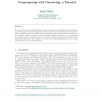180 search results - page 5 / 36 » The when, why and why not of the BETA programming language |
JSC
2010
13 years 7 months ago
2010
Narrowing is a computation implemented by some declarative programming languages. Research in the last decade has produced significant results on the theory and foundation of nar...
VL
2008
IEEE
14 years 2 months ago
2008
IEEE
Mashups – web applications that integrate multiple data sources or APIs into one interface – have attracted considerable attention in recent years. The availability of web-bas...
ECOOP
2007
Springer
14 years 13 days ago
2007
Springer
Tools that perform refactoring are currently under-utilized by programmers. As more advanced refactoring tools are designed, a great chasm widens between how the tools must be use...
ISEUD
2009
Springer
14 years 3 months ago
2009
Springer
End-user programming has become ubiquitous, so much so that there are more end-user programmers today than there are professional programmers. End-user programming empowers—but t...
ICFP
2004
ACM
14 years 8 months ago
2004
ACM
Useful type inference must be faster than normalization. Otherwise, you could check safety conditions by running the program. We analyze the relationship between bounds on normali...

